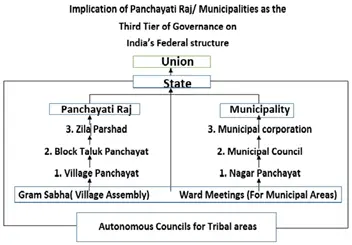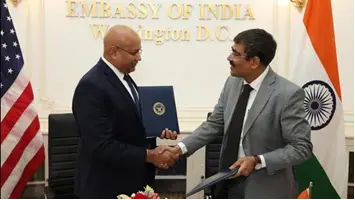Tuesday, 3rd September 2024
India’s Neighbourhood Watch, Past and Present
Why in the news?
- India’s strategic neighbourhood has undergone significant changes from 2008 to 2024.
- While India often engages in excessive self-criticism when regional events falter, overestimating its influence on the outcomes in its neighbourhood.
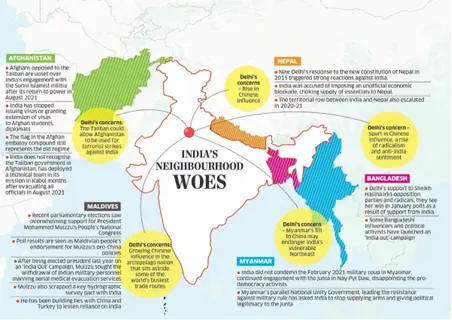
A Period of Promising Change (2008-2010) and India’s Role:
- Bangladesh: The Return of Democracy
- 2008: End of military rule and return to civilian governance under Sheikh Hasina, facilitated by India's diplomatic efforts.
- Sri Lanka: The Defeat of the LTTE
- 2009: LTTE defeated, ending a decade-long civil war. India’s strategic engagement was crucial in shaping the outcome and post-conflict reintegration.
- Maldives: Multi-Party Democracy
- 2008: Transition to multi-party democracy with Mohamed Nasheed’s election. India supported this shift towards democratic governance.
- Myanmar: Step Toward Civilian Rule
- 2010: Elections under military dominance. Daw Aung San Suu Kyi’s release signalled a gradual shift towards democracy. India balanced strategic interests with support for democratic aspirations.
- Pakistan: Civilian Government Takes Charge
- 2008: Transition from military to civilian government after Pervez Musharraf’s ousting. India's relations were tense but offered potential for dialogue post-2008 Mumbai attacks.
The Present Situation (2024) and Challenges for India:
- Bangladesh: Government Collapse
- August 2024: Sheikh Hasina’s government fell due to a democracy deficit and protests. India's failure to engage with opposition exacerbated the situation, questioning its strategy in Bangladesh.
- Sri Lanka: Economic and Political Crisis
- 2022: President Gotabaya Rajapaksa fled amid protests. India provided a $4 billion bailout, maintaining strong relations despite the political upheaval.
- Maldives: Electoral Upset
- 2024: President Mohamed Muizzu’s unexpected victory caught India off guard. Past engagement with Nasheed indicates India's learning from its mistakes.
- Myanmar: Return to Military Rule
- 2021: Military coup led to ongoing turmoil, affecting India's northeastern states. India faces challenges in navigating the unstable situation.
- Afghanistan and Pakistan: Regional Challenges
- 2021: Taliban's return to power. India was sidelined in U.S.-Taliban engagements and now manages fallout independently. Pakistan’s civilian government collapse in 2022 highlights ongoing challenges.
Suggestions for Making India’s Response and Strategic Imperatives:
- Terrorism and Illegal Migration: Enhance border security to address threats from terrorism, illegal migration, and drug trafficking. Monitor demographic changes and ensure cooperation between the Ministry of External Affairs, Ministry of Home Affairs, and state governments.
- Relations with China and Pakistan: Address terrorism from Pakistan through regional and multilateral platforms. Establish a common counter-terrorism platform and build economic ties with Pakistan.
- Investment in Border Infrastructure: Improve border infrastructure, including roads, railways, and waterways. Consider setting up a regional development fund for connectivity projects.
- Monitoring LOC Projects: Accelerate the completion of Line of Credit (LOC) projects, which have grown significantly. Strengthen monitoring through the Ministry of External Affairs and Joint Project Monitoring Committees.
- Defence and Maritime Security: Enhance defence cooperation with neighbours and increase maritime domain awareness in the extended neighbourhood.
- Development in North-Eastern Region: Align the Neighbourhood First and Act East policies to boost economic development, connectivity, and security in the North-Eastern states.
- Tourism Promotion: Invest in tourism, including medical tourism, leveraging India’s role as a major source of tourists for South Asia.
- Multilateral Organisations: Strengthen engagement with regional mechanisms like SAARC and BIMSTEC. Conduct regular reviews of bilateral and multilateral relationships to enhance policy impact.
Conclusion
Over the past 16 years, India’s neighbourhood has been volatile with significant challenges and successes. India’s approach needs sustained engagement rather than episodic interventions to maintain influence and foster regional stability.
|
UPSC Civil Services Examination, Previous Year Questions (PYQs) Prelims: Q:1 Elephant Pass, sometimes seen in the news, is mentioned in the context of the affairs of which one of the following? (2009)
Ans: (d)
Q:2 Consider the following statements: (2020)
Which of the statements given above is/are correct?
Ans: (b)
Mains: Q:1 “China is using its economic relations and positive trade surplus as tools to develop potential military power status in Asia”. In the light of this statement, discuss its impact on India as her neighbour. (2017) |
Source: TH
Rights of the accused in PMLA cases and recent SC Verdicts
Why in the news?
- The Supreme Court of India, in the case Vijay Madanlal Choudhary v. Union of India (2022), upheld key provisions of the Prevention of Money Laundering Act (PMLA), reinforcing the Enforcement Directorate's (ED) broad powers.
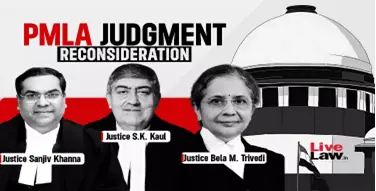
What is PMLA?
- About:
- The Prevention of Money Laundering Act, 2002 (PMLA) aims to prevent money laundering and confiscate property derived from such activities, targeting crimes like drug trafficking, smuggling, and terrorism financing.
- Key Provisions of PMLA:
- Offences and Penalties: Defines money laundering offences with penalties including rigorous imprisonment and fines.
- Attachment and Confiscation: Allows attachment and confiscation of property involved in money laundering, overseen by an Adjudicating Authority.
- Reporting Requirements: Mandates banks and financial institutions to maintain records and report suspicious transactions to the Financial Intelligence Unit (FIU).
- Appellate Tribunal: Section 25 establishes an Appellate Tribunal to hear appeals against orders from the Adjudicating Authority.
- Recent Amendments Related to PMLA:
- Restoration of Confiscated Property (2019): New Rule 3A allows the Special Court to publish notices for claimants of confiscated property after charges are framed.
- Maintenance of Records (2023): Expanded disclosure requirements for NGOs and clarified the definition of "Politically Exposed Persons" (PEPs) to align with FATF recommendations.
- Concerns Regarding PMLA, 2002:
- Broad Definition of Proceeds of Crime: Concerns over the broad interpretation, which may include legal transactions.
- Coverage of Numerous Offences: PMLA’s schedule includes many offences unrelated to its original intent of combating drug money laundering.
- Arrest Without Written Grounds: ED officers have been criticised for not providing written grounds for arrest, violating Article 22(1) of the Constitution and Section 19(1) of PMLA, as reaffirmed by the Supreme Court in the case of NewsClick founder Prabir Purkayastha.
Key Relaxations Extended by the Supreme Court:
- On Grounds of Arrest:
- Section 19 of the PMLA grants the ED the power to arrest based on reasonable belief of guilt.
- Initially, in the Vijay Madanlal Choudhary case, the Court ruled that the ED need not provide the Enforcement Case Information Report (ECIR) but only inform the accused of the arrest reasons.
- Recent Intervention:
- In Pankaj Bansal v. Union of India (2023), the Court mandated that the grounds of arrest must always be provided in writing, underscoring that failure to do so renders the arrest illegal.
- This ensures the accused's right to be informed under Article 20 of the Constitution is upheld.
- On Bail for Undertrials:
- Section 436A of the CrPC, which allows bail if an undertrial has served half the maximum sentence, was extended to PMLA cases in Vijay Madanlal Choudhary.
- Impact of Amendments:
- The introduction of Section 479 of the Bharatiya Nagarik Suraksha Sanhita could limit this bail provision, particularly in cases with multiple charges.
- Despite this, the Court reiterated in August 2024 that "bail is the rule and jail is the exception," applying even to PMLA cases.
- On ‘Need and Necessity to Arrest’:
- In July 2024, the Supreme Court granted interim bail to Delhi CM Arvind Kejriwal, questioning the necessity of his arrest by the ED when the evidence was available months prior.
- The case highlighted the requirement for the ED to base arrests on substantial, court-admissible evidence and referred the "need and necessity to arrest" issue to a five-judge bench for further consideration.
- On Relaxing Twin Conditions:
- Section 45 of the PMLA imposes stringent conditions for bail, reversing the usual burden of proof.
- However, in August 2024, the Court granted bail to Manish Sisodia, acknowledging prolonged pre-trial detention (17 months in his case) as a valid reason for relaxing these conditions.
- On Bail Exception for Women:
- The Supreme Court granted bail to BRS leader K Kavitha under the Section 45 exception for women, overruling a Delhi High Court decision.
- The ruling clarified that the exception applies universally to women, regardless of their educational or social status.
- On Confession to ED Officer:
- Section 50 of the PMLA permits the ED to summon individuals and record statements, which the Court in Vijay Madanlal Choudhary upheld as not violating the right against self-incrimination.
- Recent Ruling: In Prem Prakash v. Union of India (2024), the Court emphasised that confessions made in judicial custody may not be voluntary due to potential coercion and are therefore inadmissible as evidence, reinforcing protections against self-incrimination.
Conclusion:
These rulings demonstrate the Supreme Court's efforts to balance the enforcement of the PMLA with the protection of fundamental rights. While the Act remains a robust tool against money laundering, the Court's interventions ensure that the rights of the accused are not unduly compromised, particularly concerning arrest, bail, and self-incrimination.
|
UPSC Civil Services Examination, Previous Year Questions (PYQs) Prelims Q:1 Which one of the following groups of items is included in India’s foreign-exchange reserves? (2013)
Ans: (b)
Mains Q:1 Discuss how emerging technologies and globalisation contribute to money laundering. Elaborate measures to tackle the problem of money laundering both at national and international levels. (2021) Q:2 India’s proximity to the two of the world’s biggest illicit opium-growing states has enhanced her internal security concerns. Explain the linkages between drug trafficking and other illicit activities such as gunrunning, money laundering and human trafficking. What countermeasures should be taken to prevent the same? (2018) |
Source: IE
75 Years of Supreme Court
Why in the news?
- Recently, the President of India unveiled a new flag and insignia for the Supreme Court of India to mark its 75th year of establishment.
- The new flag features the Ashoka Chakra, the Supreme Court building, and the book of the Constitution of India.
- Additionally, the Prime Minister released a commemorative postage stamp to celebrate 75 years of the Supreme Court.

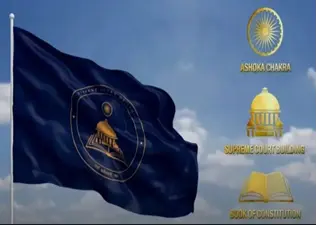
Evolution of the Supreme Court in 75 Year:
- First Phase (1950-1967): Adherence to Constitutional Text and Judicial Restraint
- Judicial Review: The judiciary maintained a conservative approach, focusing on interpreting the Constitution as written and exercising judicial review without overstepping boundaries.
- Avoidance of Ideological Influence: The judiciary avoided aligning with government ideologies, as seen in the Kameshwar Singh case (1952), where it declared the abolition of zamindari illegal but refrained from nullifying constitutional amendments.
- Respect for Legislative Supremacy: In cases like Champakam Dorairajan (1951), the judiciary struck down reservations in educational institutions but adhered to a positivist interpretation of the Constitution, avoiding confrontation with Parliament.
- Second Phase (1967-1976): Judicial Activism and Confrontation with Parliament
- Expansion of Fundamental Rights: The Golak Nath judgement (1967) marked a shift towards a more expansive interpretation of fundamental rights, challenging Parliament's legislative power.
- Landmark Rulings on Constitutional Amendments: The Kesa Vananda Bharati case (1973) introduced the 'basic structure' doctrine, limiting Parliament's power to amend the Constitution.
- Impact of Emergency on Judicial Independence: The ADM Jabalpur case (1976) marked a low point for constitutional democracy, as the judiciary supported the government's suspension of the right to life during the national emergency.
- Third Phase (1978-2014): Judicial Activism and Expansion of Public Interest Litigation (PIL)
- Course Correction Post-Emergency: The Maneka Gandhi case (1978) broadened the interpretation of Article 21, expanding the scope of the right to life and personal liberty.
- Rise of Public Interest Litigation (PIL): The judiciary allowed public-spirited individuals to file petitions on behalf of marginalised groups, leading to increased access to justice.
- Collegium System: The judiciary introduced the collegium system for appointing judges, which was later challenged by the National Judicial Appointments Commission Act (2014) but struck down to maintain judicial independence.
- Fourth Phase (2014-Present): Liberal Interpretation of the Constitution
- Liberal Interpretation: The Supreme Court upheld the revocation of Article 370, integrating Jammu and Kashmir into the Indian Union.
- Sustaining Judicial Activism: The judiciary continued to assert its role in protecting constitutional rights, such as invalidating the opaque electoral bonds scheme and striking down Section 497 of the Indian Penal Code, which criminalised adultery.
Key Challenges Facing the Supreme Court of India
- Volume of Pending Cases: As of the end of 2023, the Supreme Court had 80,439 pending cases, leading to delays in justice delivery and undermining the judiciary's efficiency and credibility.
- Dominance of Special Leave Petitions (SLPs): SLPs constitute the majority of the Supreme Court's case list, limiting the court's ability to address a diverse range of issues effectively.
- Selective Prioritization of Cases: The "pick and choose model" of case prioritisation has led to perceptions of preferential treatment, with high-profile cases often receiving swift attention.
- Judicial Evasion: The backlog has sometimes led to "judicial evasion," where important cases are avoided or delayed, such as challenges to the Aadhaar biometric ID scheme and the electoral bonds case.
- Conflict of Interest and Integrity: Allegations of corruption within the judiciary pose challenges to its integrity and public confidence.
- Concerns of Appointment of Judges: The process of judicial appointments, particularly the collegium system, has been contentious, with calls for reforms to increase transparency and accountability.
Way Forward:
- All India Judicial Recruitment: Establish a national standard for judicial recruitment to ensure consistency and quality across states, improving judicial efficiency.
- Case Management Reforms: Implement advanced case management techniques, such as the e-Courts Project, to digitise and automate court operations, reducing case backlog.
- Promote Alternate Dispute Resolution (ADR): Encourage the use of ADR mechanisms for cases that do not require Supreme Court intervention, as outlined in the Arbitration and Conciliation Act, 1996.
- Transparent Case Listing: Develop a transparent case listing and prioritisation protocol, with a feature on the Supreme Court Portal to publicly track case statuses and priorities.
- Clarify Institutional Goals: Define and communicate clear institutional goals, using frameworks like Judicial Performance Evaluation to assess and realign the court’s objectives.
- Strengthen Accountability Mechanisms: Implement stricter accountability measures for judges, such as establishing an Independent Judicial Accountability Commission similar to the Central Vigilance Commission for government officials.
|
UPSC Civil Services Examination Previous Year Question (PYQ) Prelims Q:1 With reference to the Indian judiciary, consider the following statements: (2021)
Which of the statements given above is/are correct?
Ans: (c)
Q:2 Consider the following statements: (2019)
Which of the statements given above is/are correct?
Ans: (b)
Q:3 With reference to the Constitution of India, consider the following statements: (2019)
Which of the statements given above is/are correct?
Ans: (d)
Mains Q:1 Constitutional Morality’ is rooted in the Constitution itself and is founded on its essential facets. Explain the doctrine of ‘Constitutional Morality’ with the help of relevant judicial decisions. (2021) Q:2 Judicial Legislation is antithetical to the doctrine of separation of powers as envisaged in the Indian Constitution. In this context justify the filing of a large number of public interest petitions praying for issuing guidelines to executive authorities. (2020) Q:3 Critically examine the Supreme Court's Judgement on ‘National Judicial Appointments Commission Act, 2014’ with reference to appointment of judges of higher judiciary in India. (2017) |
India has a special China problem above world’s
Why in the news?
- External Affairs Minister S. Jaishankar highlighted India’s "special China problem," which he believes is more pressing than the general issues faced by other countries with China.
- This special focus calls for rigorous scrutiny of Chinese investments due to strained border relations.
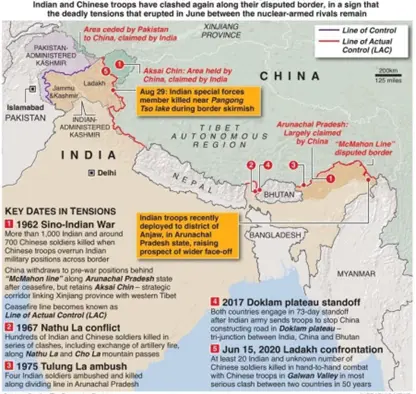
India – China Border Dispute:
- Western Sector (Aksai Chin): China administers Aksai Chin, which India claims as part of Jammu and Kashmir. The area is uninhabited and includes disputed regions like Daulat Beg Oldi.
- The most serious recent episodes of conflict were in Galwan Valley in Ladakh in 2020 and in Tawang in Arunachal Pradesh in 2022.
- Central Sector: This 625 km boundary has minimal controversy, with no major disagreements between India and China.
- Eastern Sector (McMahon Line): The McMahon Line, drawn in 1913-14, divides British India from Tibet. China rejects this boundary and claims parts of Arunachal Pradesh, which it refers to as Southern Tibet.
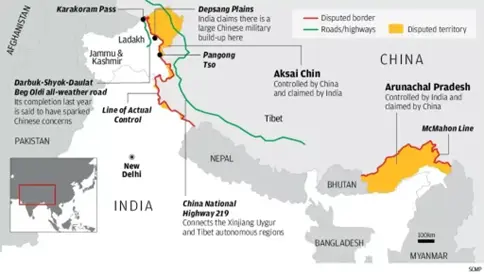
Border Dispute Settlement Mechanisms:
- Agreement on the Maintenance of Peace and Tranquillity (1993): Renunciation of the use of force, recognition of the Line of Actual Control (LAC), and resolution of the border issue through negotiations.
- Agreement on Confidence Building Measures in the Military Field along the LAC (1996): Pledges on non-aggression, prior notification of large troop movements, and exchange of maps to address LAC disagreements.
- Border Defence Cooperation Agreement (2013): Established after the Depsang Valley incident, focusing on enhancing border defence cooperation and reducing tensions.
BRO Infrastructure Projects:
- Road Infrastructure Completion: The BRO is finalising roads such as the Nimu-Padam-Darcha and constructing the Shinku La tunnel, which will be the highest in the world.
- Leh Connectivity: Three routes to Leh include the new Nimu-Padam-Darcha road, reducing distance to Manali by 60 km.
- Ladakh Border Roads: Key roads include the Leh-Demchok road and connections from Durbuk to Nyoma.
- ICBR Programme: Focuses on 73 strategic roads in Arunachal Pradesh and Ladakh under its first two phases.
- Arunachal Pradesh Frontier Highway: A major 1,800-km highway project near the Myanmar border.
- Other Projects: Includes the Sungal tunnel and Lipulekh Pass Road.
- Increased Focus: Since 2020, there's been a surge in border infrastructure development in Ladakh and Northeast India.
Key Highlights of EAM’s Speech:
- Special China Problem: India’s challenges with China are distinct from those faced by other countries.
- Scrutiny of Chinese Investments: India’s strained border relations justify careful examination of Chinese investments.
- Border Situation and Diplomacy: Recent talks show progress in resolving the border standoff that began in May 2020, with efforts to "narrow down differences."
- Trade Deficit and China’s Position: Jaishankar highlighted the trade deficit with China due to its unique production advantages, stressing the need for policies that account for China's political and economic system.
- Economics and Security: The intersection of economics and national security is crucial, particularly concerning reliance on Chinese technology.
- Ongoing Border Standoff: The standoff has lasted over four years with significant troop deployments, though some friction points remain unresolved.
Source: IE
National Conference of the District Judiciary
Why in the news?
- PM Modi inaugurated the National Conference of District Judiciary on August 31, 2024, at Bharat Mandapam, New Delhi.
- The two-day conference, organised by the Supreme Court of India, will cover issues related to District Judiciary, including infrastructure, human resources, inclusive courtrooms, judicial security, wellness, case management, and training.
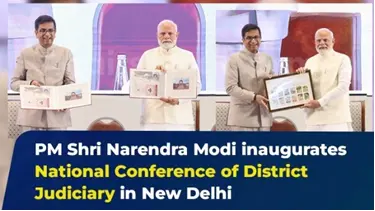
Evolution of Modern Judiciary in India:
- Introduction of Judicial System: The British introduced an Anglo-Saxon judicial system in India.
- Royal Charter of 1661: Empowered the Governor and Council to adjudicate according to English laws.
- Regulating Act of 1773: Established the Supreme Court of India in Calcutta.
- Supreme Courts in Madras and Bombay: Extended British judicial system to these presidencies.
- Dual Judicial Systems:
- English Royal Courts in presidencies.
- Indian Adalat/Sadr Courts in provinces.
- High Court Act of 1861: Merged the dual systems into High Courts and replaced native courts.
- Judicial Committee of the Privy Council: Acted as the highest court of appeal.
- Government of India Act of 1935: Set up the Federal Court as an intermediate appellate body.
- Federal Court’s Limited Power: Could only issue declaratory judgments with limited enforcement power.
- Unified Court System: Transitioned to a three-tier structure starting from lower courts to the Supreme Court.
Key Highlights of PM Modi's Speech:
- Supreme Court's 75-Year Journey: Reflects the evolution of the Constitution and democracy.
- Judiciary's Role in Democracy: The Supreme Court is seen as the custodian of the Constitution.
- Modernization Efforts: Significant investments and technological advancements, including e-Courts and AI.
- Bharatiya Nyaya Sanhita: New legal code focusing on citizen dignity and digital evidence.
- Women and Child Safety: Enhanced laws and fast-track courts for swift justice.
- Vision for Developed India: The district judiciary is vital for realising 'Viksit Bharat' and 'Naya Bharat.'
Key Highlights of CJI D Y Chandrachud's Speech:
- Legal Education in Regional Languages: Aims to make legal knowledge accessible in native languages.
- District Judiciary as Backbone: Advocates ending the term "subordinate judiciary" as outdated.
- Challenges for District Judiciary: Includes affordability of legal representation and geographic access.
- Adoption of Technology: Emphasises digitization, e-sewa kendras, and video conferencing.
- Increasing Women Participation: Noted the rise of women in district judiciary roles.
- Translation of Supreme Court Judgments: 73,000 judgments translated into all constitutionally recognized languages.
Source: PIB
Rule 170 of the Drugs and Cosmetics Act
Why in the news?
- Recently, the Supreme Court stayed a Central government notification, whereby Rule 170 of the Drugs and Cosmetics Rules, 1945, was omitted.
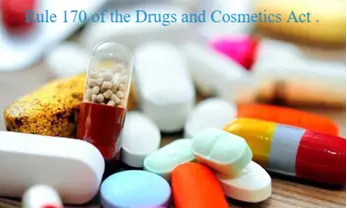
About Rule 170 of the Drugs and Cosmetics Act:
- About:
- Introduced in 2018, Rule 170 was established to prevent the misleading advertisement of AYUSH products, focusing on the manufacture, storage, and sale of Ayurvedic, Siddha, and Unani medicines.
- The rule seeks to regulate advertisements by ensuring that they meet specific safety, effectiveness, and quality standards.
- Key Provisions of Rule 170
- Advertisement Prohibition: AYUSH drug manufacturers are prohibited from advertising their products without prior approval and a unique identification number from the state licensing authority.
- Submission Requirements: Manufacturers must submit comprehensive details, including textual references, the rationale for the medicine, indications for use, and evidence of safety and effectiveness.
- Grounds for Rejection: Applications may be rejected for several reasons, such as:
- Lack of contact details.
- Obscene or vulgar content.
- Promotion of products for the enhancement of sexual organs.
- Testimonials from celebrities or government officials.
- References to government organisations.
- Misleading or exaggerated claims.
- Reason for Introduction
- Rule 170 was introduced in response to concerns raised by a parliamentary standing committee regarding the prevalence of misleading claims in AYUSH product advertisements.
- The need for proactive measures by the AYUSH ministry to address these concerns led to the establishment of this regulation.
- Challenges in Regulating AYUSH Drugs
- Licensing Requirements: Like allopathic medicines, AYUSH drug manufacturers must obtain a licence from the drug controller.
- Absence of Clinical Trials: Unlike allopathic medicines, AYUSH drugs are not required to undergo phase I, II, and III clinical trials or equivalence studies for approval.
- Effectiveness Proof Requirement: Drugs containing specific ingredients or traditional drugs used for new indications must provide proof of effectiveness as per the Act.
- Reasons for AYUSH Ministry's Recommendation to Ignore Rule 170
- Expert Recommendation by ASUDTAB:
- The Ayurvedic, Siddha, and Unani Drugs Technical Advisory Board (ASUDTAB), an expert body responsible for regulating AYUSH drugs, suggested omitting Rule 170 during a meeting in May 2023.
- Overlapping Legislative Amendments:
- The suggestion to omit Rule 170 was influenced by ongoing considerations for amendments to the Drugs and Magic Remedies Act, a law also aimed at preventing misleading advertisements.
- Both the health and AYUSH ministries were involved in these legislative changes.
- Advisory to State Licensing Authorities:
- In response to ASUDTAB's recommendation and the anticipated legislative amendments, the AYUSH Ministry advised state licensing authorities to disregard Rule 170, considering it redundant or potentially conflicting with the upcoming legal framework.
- Expert Recommendation by ASUDTAB:
Source: TH
Uri-I Hydroelectric Project
Why in the news?
- Recently, The Expert Appraisal Committee (EAC) of the Union Ministry of Environment, Forest and Climate Change has deferred the proposal for the grant of Environmental Clearance (EC) to the Stage-II of the Uri-I Hydroelectric Project.
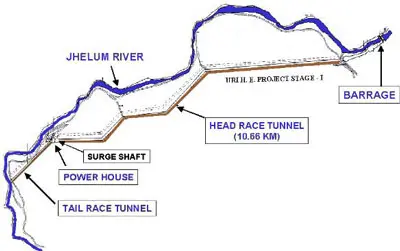
About the Uri-I Hydroelectric Project:
- Recent Development:
- On September 2, 2024, the Expert Appraisal Committee (EAC) of the Union Ministry of Environment, Forest, and Climate Change deferred the proposal for granting Environmental Clearance (EC) to the Stage-II of the Uri-I Hydroelectric Project.
- About:
- Location: Uri-I Hydroelectric Project is situated on the Jhelum River in Uri town, Baramulla district of Jammu & Kashmir, near the Line of Control (LoC) between India and Pakistan.
- Commissioning: The project was commissioned in 1997.
- Capacity: It has a total installed capacity of 480 MW, with four units, each generating 120 MW.
- Ownership and Operation: The project is owned by the Central Government and operated by the National Hydroelectric Power Corporation Limited (NHPC).
Key Facts about the Jhelum River:
- Geography:
- The Jhelum River flows through both India and Pakistan and is a tributary of the Indus River.
- It is the primary waterway in the Kashmir Valley and is the westernmost of the five rivers of Punjab, passing through the Jhelum District in Pakistan's Punjab province.
- Course:
- Origin: The river originates from Verinag Spring in Anantnag, located at the foot of the Pir Panjal range in the Kashmir Valley.
- Flow: It flows through Srinagar and Wular Lake before entering Pakistan, forming a deep and narrow gorge on its way.
- Confluence: It joins the Chenab River near Trimmu, Pakistan.
- Major Tributaries:
- Kishanganga (Neelum) River: The largest tributary, joining the Jhelum near Muzaffarabad and flowing into Punjab province, Pakistan.
- Kunhar River: The second largest tributary, connecting Pakistan-occupied Kashmir (PoK) and Pakistan near the Kohala Bridge of Kanghan Valley.
- Other Tributaries: Sandran River, Bringi River, Arapath River, Watlara River, Lidder River, and Veshaw River.
Source: DE
Ramon Magsaysay Award
Why in the news?
- On September 2, 2024, Japanese anime director Hayao Miyazaki was honoured with the Ramon Magsaysay Award, often referred to as Asia's Nobel Prize.

About the Ramon Magsaysay Award:
- About:
- The Ramon Magsaysay Award is considered Asia's premier prize and highest honour.
- It celebrates individuals who demonstrate greatness of spirit and transformative leadership in Asia.
- History:
- The award was established in 1957 and is named after Ramon Magsaysay, the beloved Philippine President who died in a plane crash in 1957.
- The award was created to honour his memory and his ideals of integrity in governance and service to the people.
- Categories:
- From 1958 to 2008, the award was given annually in six categories:
- Government Service: Recognizing outstanding public service in any branch of government.
- Public Service: Awarded to private citizens for their service to the public good.
- Community Leadership: Given for leadership that enhances the welfare of the disadvantaged.
- Journalism, Literature, and Creative Communication Arts: For effective use of media and arts in promoting the public good.
- Peace and International Understanding: For contributions to promoting friendship, tolerance, and peace across borders.
- Emergent Leadership: Recognizing young leaders (under 40) making significant contributions to social change.
- From 1958 to 2008, the award was given annually in six categories:
- Presentation:
- Awardees receive a certificate and a medallion with an embossed image of Ramon Magsaysay.
- The awards are presented annually on August 31st in Manila, Philippines, coinciding with the birth anniversary of Ramon Magsaysay.
- Significance:
- The Ramon Magsaysay Award has a long-standing reputation as a prestigious recognition of outstanding individuals and organisations across Asia who have demonstrated excellence in their respective fields and have made significant contributions to society.
Source: TH
Zombie fungus
Why in the news?
- Recently, On September 2, 2024, wildlife researcher Chris Ketola shared a video showing a tarantula infected by a zombie fungus, highlighting the eerie and fascinating interaction between the fungus and its host.

About Zombie Fungus (Ophiocordyceps unilateralis):
- Functionality:
- The zombie fungus, scientifically known as Ophiocordyceps unilateralis, parasitizes its host by draining it of nutrients and filling its body with spores, which enables the fungus to reproduce.
- The fungus exerts control over the host’s mind and motor functions, effectively turning it into a "zombie" before eventually consuming the host's body.
- Infection Targets:
- Cordyceps is a genus of fungi that predominantly targets invertebrates. The fungus mainly infects insects like ants and spiders.
- It is commonly found in pantropical regions and primarily infects carpenter ants.
Key Facts about Tarantulas:
- Classification:
- Tarantulas belong to the family Theraphosidae, which includes large, hairy spiders.
- Species and Distribution:
- There are over 900 species of tarantulas found worldwide, with the exception of Antarctica.
- Behaviour:
- Tarantulas are slow-moving on their eight hairy legs and are primarily nocturnal predators.
Source: HT
Reforming the process of judicial appointments
Context:
- The debate over India's judicial appointment system, governed by Articles 124(2) and 217(1), highlights the issues with the collegium system, such as lack of transparency and accountability.
- The NJAC, aimed at reforming this through a multi-stakeholder approach, was struck down by the Supreme Court in 2015.
- Compared with other countries that use diverse commissions for judicial appointments, a reformed NJAC could improve transparency and efficiency, addressing delays in justice and enhancing public confidence in the judiciary.
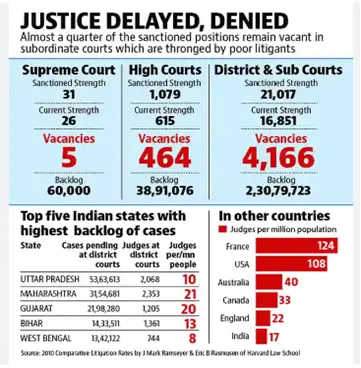
Evolution of the Collegium System:
- First Judges Case (1982):
- The Supreme Court in S.P. Gupta vs. Union of India ruled that "consultation" with the Chief Justice of India (CJI) did not equate to "concurrence."
- This reduced the CJI's primacy in judicial appointments.
- Allowed any of the four constitutional authorities listed in Article 217 to initiate High Court appointments, favouring the executive's role.
- This practice was in place for 12 years.
- Second Judges Case (1993):
- The Supreme Court in Supreme Court Advocates-on-Record Association vs. Union of India overruled the First Judges Case by a 7:2 majority.
- Established that "consultation" means "concurrence," granting the primary role in judicial appointments to the CJI and senior-most judges.
- Formalised the collegium system where the CJI and senior judges collectively decide on appointments.
- Third Judges Case (1998):
- In a Presidential reference, the Supreme Court reaffirmed the decision of the Second Judges Case.
- Held that judicial appointments should be made by the CJI in consultation with the four senior-most Supreme Court judges.
- This ruling solidified the collegium system, making the collective opinion of the CJI and senior judges binding on the government.
- Memorandum of Procedure (MoP):
- Drafted by the Ministry of Law and Justice as per the Supreme Court's directives in the Second and Third Judges Cases.
- Outlines the process for appointing Supreme Court and High Court judges.
- In 2015, the Supreme Court directed revisions to enhance transparency, leading to a deadlock over certain clauses.
- Proposals to supplement the MoP are currently under Supreme Court consideration.
- National Judicial Appointments Commission (NJAC):
- Proposed by the National Commission to Review the Working of the Indian Constitution (2002).
- The NJAC Bill was introduced in 2013 and reintroduced in 2014, leading to the NJAC Act, 2014, under the Ninety-ninth Constitutional Amendment.
- Aimed to involve the CJI, two senior Supreme Court judges, the Law Minister, and two eminent persons in judicial appointments.
- Declared unconstitutional by the Supreme Court in 2015 due to concerns about inadequate judicial representation and excessive executive involvement.

Status of Judicial Pendency in India (As of June 2024):
- Judicial Appointments:
- Supreme Court: Ended 2023 with 80,439 open cases.
- High Courts: 25 high courts have over 61.7 lakh pending cases.
- District Courts: 4.5 crore cases are pending out of 5.1 crore, representing over 87% of the total caseload.
- Other Significant Facts:
- The government is the largest litigant, accounting for 50% of the pending cases.
- Land and property disputes are the most frequent type of pending cases.
- The COVID-19 pandemic significantly contributed to the increase in pendency.
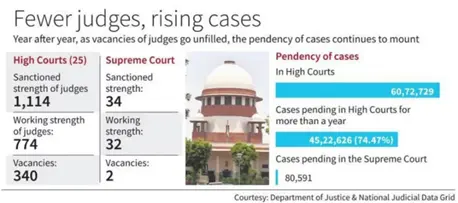
Arguments in Favour of the Collegium System in India:
- Judicial Independence: The Collegium system ensures judges appoint peers, preserving judiciary independence from political influence, thus upholding fair justice.
- Merit-Based Selection: Judges are chosen for their qualifications and experience, ensuring appointments are made based on competence and not just academic credentials.
- Diversity and Inclusivity: The system promotes diverse representation, including women and marginalised communities, reflecting India's societal diversity. Notable examples include Justice Leila Seth and the upcoming appointment of Justice BV Nagarathna.
- Institutional Continuity: Reliance on senior judges maintains institutional memory and judicial consistency, essential for stable legal practices amidst political changes.
Arguments Against the Collegium System in India:
- Transparency Issues: The system's opaque decision-making process undermines public trust, as seen in the controversial appointment of Soumitra Sen despite allegations of misconduct.
- Nepotism Risk: The closed deliberations may foster nepotism and cronyism, with personal connections sometimes influencing appointments over merit.
- Diversity Shortcomings: The system has not effectively ensured diverse representation in terms of gender, caste, and region, potentially leading to an unrepresentative judiciary.
- Lack of External Oversight: Without external input, the system’s decisions may not reflect broader societal concerns. The 2016 Parliamentary Report recommended a more participatory approach involving both judiciary and executive.
Judicial Appointment Mechanisms Across Countries:
- United States of America:
- Appointment Process: Federal judges are appointed by the President with the Senate's advice and consent. Candidates are assessed by the American Bar Association and reviewed by the Senate Judiciary Committee before a Senate vote.
- Tenure: Judges hold office for life, subject to "good behaviour," with no fixed retirement age.
- United Kingdom:
- Appointment Process: Since the establishment of the UK Supreme Court in 2005, the Judicial Appointments Commission (JAC) handles appointments. The JAC includes barristers, judges, solicitors, laypeople, and magistrates.
- Residual Power: The Lord Chancellor retains the power to reject candidates based on merit.
- Other Countries:
- Canada, South Africa, and Various U.S. Jurisdictions: Use independent Judicial Appointment Commissions, which are noted for their effectiveness.
- Ireland, Israel, New Zealand, and the Netherlands: Employ judicial appointment committees to oversee the selection process.
Proposed Enhancements for the Collegium System:
- Enhanced Transparency and Accountability:
- Implement clear guidelines and procedures for appointments.
- Incorporate public consultations to ensure the judiciary remains accountable and trustworthy.
- Balanced Role for the Executive:
- Increase the executive's role in the appointment process while maintaining judicial independence.
- Revise the NJAC or introduce a similar body with representatives from the judiciary, executive, and civil society to balance independence and accountability.
- Merit-Based Appointments:
- Strictly adhere to merit-based criteria, focusing on qualifications, experience, and judicial acumen for appointments.
- Ensure the selection of the most competent and qualified candidates.
- Time-Bound Appointments:
- Establish strict timelines for the Collegium process to prevent prolonged vacancies.
- Ensure the judiciary remains fully staffed and capable of handling its caseload efficiently.
- Public Participation:
- Actively seek public input through consultations, online forums, and feedback mechanisms.
- Enhance responsiveness to public needs and expectations.
Conclusion
Reforming the Collegium system to address transparency, accountability, and delays, potentially through a revised NJAC or similar reforms, could improve the efficiency and effectiveness of India's judiciary.
|
UPSC Civil Services Examination, Previous Year Question (PYQ) Prelims Q:1 Consider the following statements: (2019)
Which of the statements given above is/are correct? (a) 1 only (b) 2 only (c) Both 1 and 2 (d) Neither 1 nor 2
Ans: (b)
Mains Q:1 Critically examine the Supreme Court’s judgement on the ‘National Judicial Appointments Commission Act, 2014’ with reference to the appointment of judges of higher judiciary in India. (2017) |
Source: TH
Share the article
Edukemy’s Current Affairs Quiz is published with multiple choice questions for UPSC exams
MCQ
Get Latest Updates on Offers, Event dates, and free Mentorship sessions.

Get in touch with our Expert Academic Counsellors 👋
FAQs
UPSC Daily Current Affairs focuses on learning current events on a daily basis. An aspirant needs to study regular and updated information about current events, news, and relevant topics that are important for UPSC aspirants. It covers national and international affairs, government policies, socio-economic issues, science and technology advancements, and more.
UPSC Daily Current Affairs provides aspirants with a concise and comprehensive overview of the latest happenings and developments across various fields. It helps aspirants stay updated with current affairs and provides them with valuable insights and analysis, which are essential for answering questions in the UPSC examinations. It enhances their knowledge, analytical skills, and ability to connect current affairs with the UPSC syllabus.
UPSC Daily Current Affairs covers a wide range of topics, including politics, economics, science and technology, environment, social issues, governance, international relations, and more. It offers news summaries, in-depth analyses, editorials, opinion pieces, and relevant study materials. It also provides practice questions and quizzes to help aspirants test their understanding of current affairs.
Edukemy's UPSC Daily Current Affairs can be accessed through:
- UPSC Daily Current Affairs can be accessed through Current Affairs tab at the top of the Main Page of Edukemy.
- Edukemy Mobile app: The Daily Current Affairs can also be access through Edukemy Mobile App.
- Social media: Follow Edukemy’s official social media accounts or pages that provide UPSC Daily Current Affairs updates, including Facebook, Twitter, or Telegram channels.


